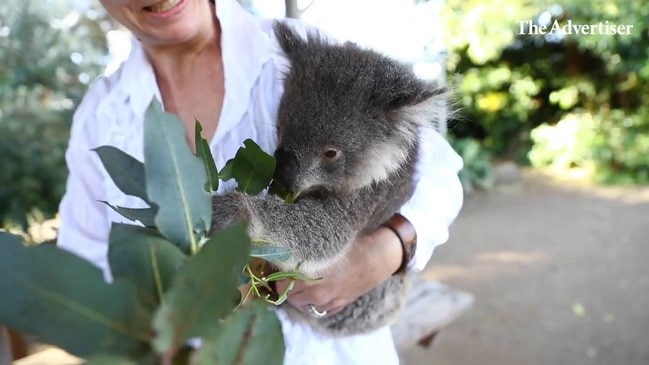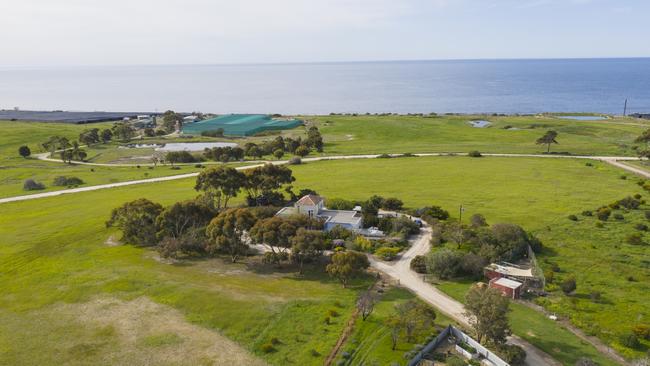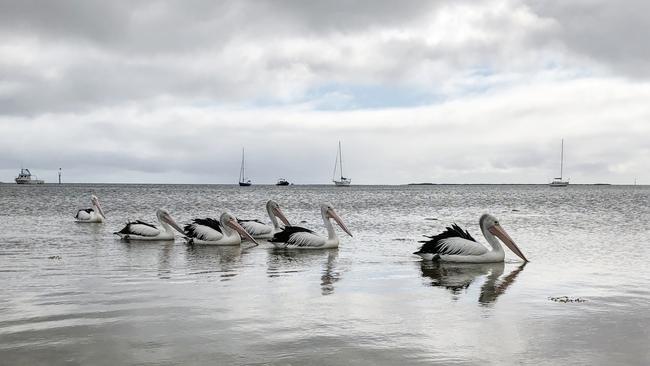An Island Divided: The $35m plan splitting KI
A battle is brewing over the future of Kangaroo Island’s sleepy Smith Bay as a timber company ups the ante in its bid to build a seaport at the shore — but locals aren’t shying away from the fight.

SA News
Don't miss out on the headlines from SA News. Followed categories will be added to My News.
- Kangaroo Island Plantation Timbers deep sea port redesigned
- Whale danger, road safety woes among seaport concerns
- Kangaroo Island Plantation Timbers urges support for seaport plans
- The Advertiser +Rewards — giveaways, offers and comps
Watching the water lap at the quiet shores of Smith Bay, it would be easy to be oblivious to the battle underway over its future.
On one side sits an abalone farm — the other, undeveloped bushland home to native animals including kangaroos, koalas and echidnas.
There is little else to see in the area and locals say that’s the way they like it.
Kangaroo Island Plantation Timbers has bought a section of the land and is gunning for State Government approval to set up a deepwater port so it can finally export logs and woodchips from the trees grown on the island’s western end.
It’s been about two decades since Kangaroo Island turned to blue gum and pine plantations as a way of boosting the region’s economy when wool and lamb prices bottomed out.

Islanders are united in their desire to see the trees felled, but there is much less agreement on the plans for a port at Smith Bay on the island’s northern coastline, which has been described by some as a “pristine ecosystem”.
Kangaroo Island Plantation Timbers says the project, costing more than $40 million will create work for about 230 people.
It’s facing fierce opposition from some on the island, including Yumbah Aqaculture, which owns an abalone farm next door and says the seaport will threaten its viability.
But those who support the project argue it will provide a much-needed shot in the arm for the region’s economy and population growth.
Brian Morgan, who runs sheep about 20km from Vivonne Bay, was among those who sold part of his farmland to make way for the blue gum plantations about 20 years ago.
Farmers were doing it tough due to poor commodity prices, he says, and he needed the money to clear debt.

“The land was so much cheaper here than in the South-East, so (timber companies) could come here and buy 2000 acres rather than 1000,” the 71-year-old says.
“A lot of people were going away to work on the mainland and their wives were working wherever they could get a job.”
Two decades later, he says it’s vital the island finds a way to export the timber — and believes Smith Bay is as good a place for a port as any.
“There’s only a small group of people that live there and wherever you put it, there’s going to at least be a small group of people,” Mr Morgan says.
“I will create a lot of jobs and there will be money in it for the community.”
If the State Government approves the plans, Mr Morgan expects the timber industry is here to stay.

Closer to Kingscote, fellow sheep farmer Rodney ‘Charlie’ Bell also sees the seaport’s merits — but says it should only be approved if can successfully coexist with Yumbah.
The plantations “destroyed” the western side of the island, he says, including the town of Parndana, which suffered a huge population blow when farmers sold up their land to make way for the gums.
Catching up with The Advertiser at Bellevista Kangaroo Island — the farming business he’s handing over to his sons — he says a port should have been planned before the island’s first blue gum was planted.
The seaport project would mean more jobs and money spent on the island, and would bring upgrades to the local roads, he says.
“I think if it was a different site to Smith Bay, it would get 100 per cent approval,” says Mr Bell, who also produces canola, wheat and broad beans.
“But because of its site, it’s caused anguish because of the perceived threat to Yumbah. It will come down to the experts to make that decision.”

Tom Fryar, owner of Kangaroo Island Free Range Eggs, is among locals who backed the project in a submission to the State Government — emphasising it’s vital Yumbah isn’t affected.
“It’s 200 jobs — that’s got to be good for any country area,” Mr Fryar says.
The anti-seaport lobby has been campaigning hard against the project, arguing it poses serious risks to a range of animals, including whales and dolphins, and the echidnas that will likely be run over by trucks travelling to the port.
Among their concerns was the timber company’s plan to dredge about 100,000 cubic metres of sediment and rock to make way for the structure.
In September, Kangaroo Island Plantation Timbers announced it would extend its proposed jetty another 250m offshore — a total of about 650m — so it could do away with dredging entirely in a bid to get the project across the line.

But this hasn’t appeased the project’s opponents.
Kangaroo Island Marine Adventures’ Andrew Neighbour runs boat tours for tourists to experience the area’s marine life and says a seaport would “destroy” his business.
It should instead be built closer to the island’s plantations in an area with deeper water, he says.
He calls Smith Bay the “dolphin’s lounge room” — “They go there because it’s quiet and there’s no industrial sounds”.
“But we notice just in the busy season with a bit of extra boat traffic the behaviour of the dolphins changes a lot — they spend less time in the area,” Mr Neighbour says.

Also at Smith Bay, Charmaine Zealand runs Molly’s Run — a luxury bed and breakfast villa where international tourists pay top dollar for coastal views, gourmet food and night drives to check out the area’s wildlife.
Her plan was to ease into retirement through the business, but she’s worried that will go up in smoke, as the seaports ruins the property’s views and ambience and her property’s value plummets.
“The night skies are absolutely beautiful here and it’s what people love,” Ms Zealand says.
“The animals will just disappear.”
Extra traffic from trucks trundling down the island’s basic roads towards the port, noise, night-time light and other environmental problems brought by the project’s construction and operation were also among Ms Zealand’s concerns.
“The fact that they’re not going to do dredging I must say is a great thing, but all those other issues will remain,” she says.

OPPORTUNITIES IN NEW SEAPORT
A seaport at Smith Bay could pave the way for other Kangaroo Island companies to export their produce, the timber company pushing the project says.
Kangaroo Island Plantation Timbers community engagement director Shauna Black said the company’s project, worth more than $40 million, might make it easier for locals to transport their produce off the island.
“At the moment everything has to go via Sealink, and it lands at Cape Jervis and then it has to be trucked to Port Adelaide — that’s a lot of road miles,” Ms Black said.
“There could be a number of things that could be exported once it becomes viable.
“The State Government required us to build something that could be used by other users, so we’ll certainly investigate other opportunities and we expect other people to come to us with their ideas.”
Ms Black says the seaport will allow forestry to become a third economic pillar on Kangaroo Island, “as big or bigger than agriculture and tourism”.
“We’re talking about injecting $50 million a year into the SA economy, and $41.2 million of that will be on the island,” she said.

Kangaroo Island Plantation Timbers has signed a deal with Mitsui, which will market its timber around Southeast Asia. The woodchips can be used to make a range of products, from paper, to fabric and disposable nappies.
The company will extend the end of its proposed jetty another 250m offshore and build a fully-piled jetty, to eliminate the need for capital and maintenance dredging.
Ms Black said the changes were being made in response to community concerns about the project, including the previous plan to dredge more than 10ha of seagrass.

“The disturbance to the sea floor will be very minimal now,” she said.
The company also hoped to use large trucks, and was investigating setting up a ring route to the port.
This would reduce the number of truck movements, also allowing the company to try and restrict them to daylight hours to reduce the incidence of roadkill.
Kangaroo Island Plantation Timbers has revised its environmental impact statement for the project, and will soon lodge it with Planning Minister Stephan Knoll, who will decide whether to approve it. Construction will take up to a year.
michelle.etheridge@news.com.au
